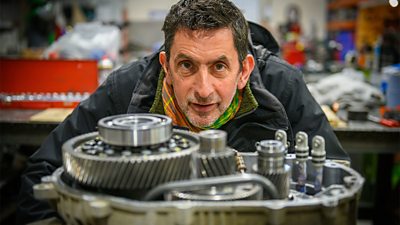A ruthless focus on energy and travel is the fastest way to cut carbon emissions on a production. Find out about some of the quickest ways to reduce a production’s footprint below.
Travel
Travel is our biggest source of emissions as an industry. Reducing travel doesn’t mean making content from our bedrooms, but ensuring we are mindful, considering the travel implications when we choose locations and making sure that we maximise what we get from the carbon dioxide (°ä°¿â‚‚) pollution we create.
1. Reduce
Keep asking: do you have to travel? Are there closer, virtual, archive, remote production or VR alternatives? Does everyone have to go? Can you use local crews and kit? Can you consolidate locations and get more filming out of one place?
2. Optimise
Are you transporting more people to a destination than the number who are there already? If so, can you swap and bring them to you? Can you use locations near public transport? Can you get more people in one vehicle, or hire a coach?
3. Electrify
Electric Vehicles, public transport, trains not planes in the UK and Europe wherever possible.
4. Don’t forget the rooms
If you are overnighting choose hotels with good sustainability polices, close to the location, and opt for shared accommodation if appropriate.
Useful links
Explore the Â鶹ԼÅÄ Archive for contemporary and period footage
Check out
Check out
Visit the to compare emissions of train, car or plane
See these
Energy
Tackling energy use is the easiest thing we can do to reduce the carbon footprint of a production and can also save money.
1. Switch off
Studios, lights, kit, even computers. If you aren’t using it, power down.
2. Green your electricity supply
Get a renewable energy tariff for your company. Request everyone whose services you use opt for a renewable energy tariff too, including studios, post-houses and locations, and prioritise those who do.
3. Ditch diesel
Accurately assess your power needs by creating a power plan and switch out diesel generators for plugging into the mains, using batteries, certified HVO or hydrogen. Find out more about these below.
Useful links
Check out
Check out
Create a power plan
1. Assess
Assess energy requirements across all departments. Encourage collaboration between key heads of departments and identify energy saving options.
2. Calculate
Calculate required capacity accurately. Generators are most efficient when running at at least 75% of their maximum load. Running a smaller generator for the same load can cut fuel consumption by over 10%.
3. Identify
Identify your power low points. Are you running generators fit for your peak load when there are minimal power needs, eg at weekends and overnight? This is the perfect time for battery/hybrid use, supplying only the power you need and reducing fuel use.
4. Track
Track fuel consumption and generator/battery usage data (‘telemetry’). This will make your reporting easier and allow you to adapt power setups to be as cost and energy efficient as possible.
5. Question
Question your energy usage throughout production. Explore sustainable options such as batteries and solar-powered lights, rigs and facilities, and alter your power plan if needed.
Ditch diesel generators
1. Using mains power
If you can tie into mains power on a certified green tariff it will almost always be the most sustainable option. It also enables simple tracking and reporting of consumption. Check location mains supplies and tariffs as early as possible.
°ä°¿â‚‚: Up to 100% emissions reduction vs diesel
Cost: Low
Complexity: Low
2. Using batteries or hybrid generators
Battery technology is evolving fast. There are full battery solutions for numerous production scenarios, whilst hybrid set-ups (battery + generator) maximise generator efficiency (reducing generator run time by up to 66%) and save fuel and money.
°ä°¿â‚‚: 25%-100% emissions reduction vs diesel, depending on type of solution
Cost: Low-mid
Complexity: Low-mid
3. Using certified HVO
Certified HVO should be used rather than diesel wherever possible. It can be used in any diesel engine and generator and can be topped-up with diesel in an emergency. Bulk/group level HVO deals may be available to productions at lower costs.
°ä°¿â‚‚: Up to 90% emissions reduction vs diesel
Cost: Low-mid (can be up to 50p per litre more expensive than diesel)
Complexity: Low
4. Using green hydrogen
The cleanest non-mains option. Units can be large and are best suited to productions with few location moves (providing additional power at a back lot, sound stage or studio). Hydrogen must be from 'green' sources (produced with renewable energy).
°ä°¿â‚‚: Up to 100% emissions reduction vs diesel
Cost: High
Complexity: Mid-high
Case studies: ditching diesel
-
 Find out how other Â鶹ԼÅÄ productions are cutting their environmental impact Inspirational case studies across scripted and unscripted content
Find out how other Â鶹ԼÅÄ productions are cutting their environmental impact Inspirational case studies across scripted and unscripted content
Reducing your carbon emissions has the potential to save money, as carbon is closely indexed to cost. However, we acknowledge that the transition to low carbon production can create pressure on budgets and schedules. If so, raise any concerns with the commissioning editor.
With thanks to for their contribution to the information on this page.
Please note the Â鶹ԼÅÄ is not responsible for the content of external website.
Further resources
-
 Sustainability homepage All our requirements and further resources
Sustainability homepage All our requirements and further resources -
 Budgeting for sustainable productions Allocating costs for sustainable production practices
Budgeting for sustainable productions Allocating costs for sustainable production practices -
 Top tips for reducing carbon emissions Focus on energy and travel
Top tips for reducing carbon emissions Focus on energy and travel -
 Producers end-to-end production guide Everything you need to know across production and editorial
Producers end-to-end production guide Everything you need to know across production and editorial -
 Carbon footprint and albert certification Delivery requirements, contacts and further information
Carbon footprint and albert certification Delivery requirements, contacts and further information -
 In depth information on a range of climate topics
In depth information on a range of climate topics
